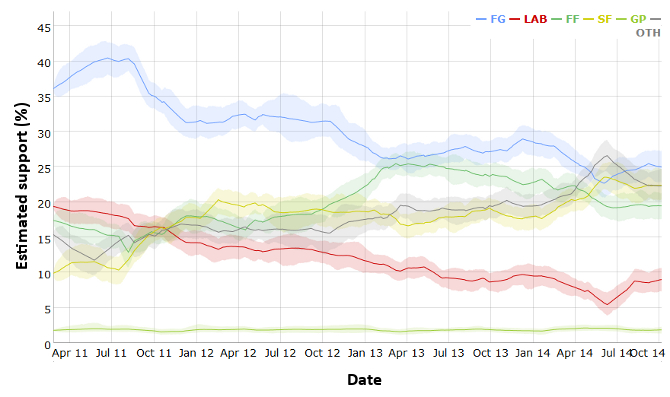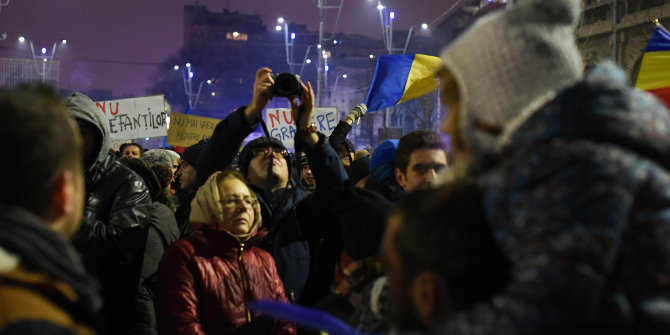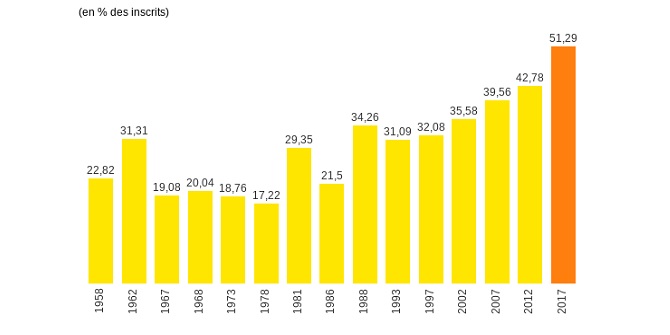 The 2011 Irish general election is generally regarded as an ‘earthquake election’, with the governing Fianna Fáil party – traditionally the dominant force in Irish politics – suffering heavy losses and a Fine Gael-Labour Party coalition coming to power in its place. With the next general election due to be held within 18 months, Rory Costello assesses how party support has developed during the course of the current parliament. He writes that while Fianna Fáil has recovered some of its support, the real story has been a surge in the popularity of independents and fringe parties.
The 2011 Irish general election is generally regarded as an ‘earthquake election’, with the governing Fianna Fáil party – traditionally the dominant force in Irish politics – suffering heavy losses and a Fine Gael-Labour Party coalition coming to power in its place. With the next general election due to be held within 18 months, Rory Costello assesses how party support has developed during the course of the current parliament. He writes that while Fianna Fáil has recovered some of its support, the real story has been a surge in the popularity of independents and fringe parties.
With the next general election due to take place sometime over the next 18 months, Irish political parties are now firmly on election footing. It is impossible to predict what will happen at this remove, but one thing seems certain: Fine Gael and Labour will not be able to replicate the overwhelming majority they achieved in the last election, as shown in the Table below.
Table: Result of the 2011 Irish general election
Note: Ireland uses a single transferable vote (STV) electoral system so the percentage vote share is for first-preference votes. There are 166 seats in the lower house of the Irish Parliament (Dáil Éireann). The United Left Alliance was an electoral alliance which at the time of the election contained the Socialist Party, the People Before Profit Alliance (PBPA), and the Workers and Unemployed Action Group (WUAG). For more information on the other parties, see: Fine Gael, Labour Party, Fianna Fáil, Sinn Féin, Green Party.
As the Chart below shows, the government parties have seen their support fall sharply since 2011 as a result of the unpopular austerity programme pursued. Initially, this austerity programme was implemented under the watchful eye of the ‘troika’ (the IMF, European Central Bank and European Commission). Ireland exited the bailout programme in December 2013, but the country still faces a large budget deficit and austerity has continued.
Chart: Polling for Irish parties since the 2011 general election
Note: The shaded areas indicate the 95% confidence intervals for the predicted support. Abbreviations for the parties are: FG (Fine Gael), LAB (Labour Party), FF (Fianna Fáil), SF (Sinn Féin), and GP (Green Party). Source: Irish Polling Indicator.
The most recent and most controversial tax-raising measure is the water charge which has just come into force. While water charges are just the latest in a long line of new taxes, it seems that for many people this is the last straw. The issue dominated the local and European elections held in May and two recent Dáil by-elections. An anti-water charges march in Dublin on 11 October was attended by up to 100,000 people, making it by most estimates the largest anti-austerity protest in Ireland since the economic crisis began.
Despite the government’s unpopularity, it would be a mistake to conclude that the next election will see a change of government. One reason is that anti-government sentiment has not crystalised around any one opposition party. Fianna Fáil has recovered somewhat from its disastrous position in 2011, but many voters are not ready to forgive the party for its role in the economic collapse that led to the bailout. Sinn Féin, a left-wing nationalist party, has seen a sharp rise in support; but it remains dogged by scandals from its murky past during the Northern Ireland Troubles, and has faced relentless criticism from other parties about the coherence of its economic policies.
Furthermore, recent improvements in the economy mean that the government may be able to ease off on austerity during the remainder of its term. We have recently seen the first expansionary budget in seven years, following better-than-expected economic figures. If the economic recovery continues, the government will see its final budget next year as an opportunity to claw back some support. In light of this, another Fine Gael-led government seems the most likely outcome of the next election.
Whichever government forms, it will probably be in a parliament that is more fragmented than at any time in its history. Single-party majority governments were once common in Ireland, but now not even the top two parties command a majority of support in opinion polls. There is a strong anti-party sentiment that has led to a surge in support for independents and fringe parties, as evidenced in the recent local elections and by-elections. Ireland is already unusual for the large number of independent members of parliament, and this looks set to increase. Independents may well hold the balance of power at the next election. Perhaps the biggest question-mark over the next government is not who will lead it, but whether it will be stable.
Please read our comments policy before commenting.
Note: This article gives the views of the author, and not the position of EUROPP – European Politics and Policy, nor of the London School of Economics. Featured image credit: Marcus Rahm (CC-BY-SA-3.0)
Shortened URL for this post: http://bit.ly/1scjVpG
_________________________________
 Rory Costello – University of Limerick
Rory Costello – University of Limerick
Rory Costello is Lecturer in the Department of Politics and Public Administration at the University of Limerick. His research interests include comparative European politics and the politics of the European Union, incorporating EU legislative decision-making, national and European elections, political representation and government performance.






